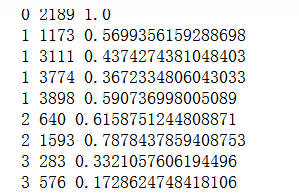垃圾
#导入邮件数据
|
1
2
3
4
5
6
7
8
9
10
11
|
import csvfile_path=r'F:\Pycharm\11.22\SMSSpamCollection'sms=open(file_path,'r',encoding='utf-8')sms_data=[]sms_label=[]csv_reader=csv.reader(sms,delimiter='\t')for line in csv_reader: sms_label.append(line[0]) sms_data.append(preprocessing(line[1]))sms.close()sms_data |
#将数据分类并对模型进行类别预测
|
1
2
3
4
5
6
7
8
9
10
11
12
13
14
15
16
17
18
19
20
21
22
23
24
25
26
27
28
29
30
31
32
33
34
35
36
37
38
39
40
41
42
43
44
45
46
|
from sklearn.model_selection import train_test_splitx_train, x_text, y_train, y_test = train_test_split(sms_data, sms_label, test_size=0.3, random_state=0, stratify=sms_label) from sklearn.feature_extraction.text import TfidfVectorizer #向量化vectorizer=TfidfVectorizer(min_df=2,ngram_range=(1,2),stop_words='english',strip_accents='unicode',norm='12')X_train=vectorizer.fit_transform(x_train)X_text=vectorizer.transform(x_test)X_traina=X_train.toarray()print(a)for i in range(1000): for j in range(5984): if a[i,j]!=0: print(i,j,a[i,j])from sklearn.navie_bayes import MultinomialNB #导入贝叶斯分类器clf= MultinomialNB().fit(X_train,y_train)y_nb_pred=clf.predict(X_test)from sklearn.metrics import confusion_matrix #导入混淆矩阵from sklearn.metrics import classification_report #分类报告print(y_nb_pred.shape,y_nb_pred)#预测结果print('nb_confusion_matrix:')cm=confusion_matrix(y_test,y_nb_pred)print(cm)print('nb_classification_report:')cr=classification_report(y_test,y_nb_pred)#分类指标文本报告print(cr)feature_name=vectorizer.get_feature_name()coefs=clf_coef_intercept=clf.intercept_coefs_with_fns=sorted(zip(coefs[0],feature_names))#对数概率p(x_i|y)与单词x_i映射n=10top=zip(coefs_with_fns[:n],coefs_with_fns[:-(n+1):-1])#最大的10个单词与最小的10个单词for (coef_1,fn_1),(coef_2,fn_2) in top: print('\t%.4f\t%-15s\t\t%.4f\t%-15s' % (coef_1,fn_1,coef_2,fn_2)) |
#运行结果






 浙公网安备 33010602011771号
浙公网安备 33010602011771号